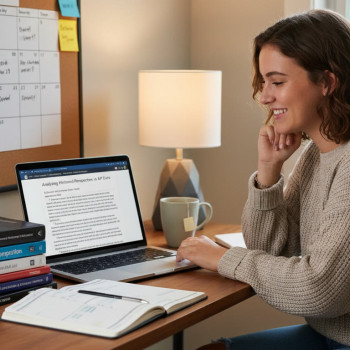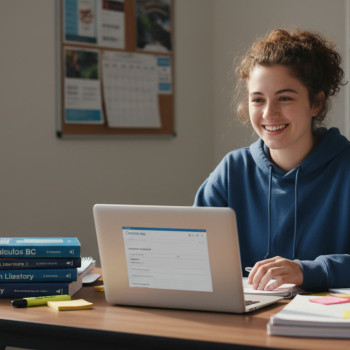Opening the Conversation: Why APs Matter for Direct-Entry Engineering
When a student tells you they want to pursue direct-entry engineering — whether it’s Electrical, Mechanical, Civil, or Computer Engineering — they often mean: “I want to be challenged early, build technical credibility, and increase my odds of acceptance into top engineering programs.” Advanced Placement (AP) courses and exams are a major lever toward that goal. But knowing the why isn’t the same as knowing the how or what to say. This guide gives counselors, parents, and students practical advising scripts and study frameworks that translate aspiration into action.

What APs Do for a Direct-Entry Engineering Applicant
- Signal academic readiness — APs show colleges you can handle college-level rigor.
- Demonstrate subject mastery — AP Calculus, AP Physics, and AP Chemistry are particularly meaningful for engineers.
- Give placement or credit — many schools award credit or let you skip introductory classes, freeing time for advanced engineering coursework.
- Improve STEM profile — strong AP performance strengthens your transcript vs. peers.
- Build confidence — mastering hard AP content builds a foundation for first-year engineering challenges.
Advising Scripts: Short, Medium, and Long Conversations
Different contexts call for different scripts. Below are three lengths you can use verbatim or adapt. Use a calm, encouraging tone; the goal is to guide, not to push.
1) Three-Minute Script — Quick Standalone Conversation (for hallway check-ins)
“I’m proud you’re thinking about engineering. Let’s pick APs that show depth and readiness: AP Calculus AB or BC, AP Physics (1 or C, depending on your background), and AP Chemistry if you’re interested in materials or chemical engineering. Balance tough courses with at least one lighter course so you don’t burn out. Start your schedule now: plan when you’ll review notes weekly and when you’ll take practice AP exams. If you’d like, we can set up short weekly check-ins to keep things on track.”
2) Fifteen-Minute Script — Classroom or Counseling Session
“Tell me which branch of engineering interests you most and why. That helps us prioritize courses and projects. For most direct-entry programs, AP Calculus and AP Physics are high-impact; if you plan on computer engineering, add AP Computer Science A. We’ll plan a two-year roadmap: sophomore year strength-building (pre-calculus, honors physics), junior year take AP Calculus and AP Physics, and senior year take AP Chemistry or an additional AP math if available. We’ll also pick a project — build a simple circuit, program a sensor, or design a small structure — to demonstrate hands-on skills on your application. If you’d like targeted tutoring for AP concepts or exam strategies, Sparkl’s personalized tutoring can match you with engineers-turned-tutors for 1-on-1 coaching and tailored study plans.”
3) Thirty-Minute Deep Advising Script — Parent, Student, and Counselor
“Let’s walk through your transcript, extracurriculars, and timeline. We want to make sure the student is academically competitive while staying healthy. Step one: confirm math pathway (Algebra I → Geometry → Algebra II → Precalculus → Calculus AB/BC). Step two: science sequence (biology, chemistry, physics) with APs where appropriate. Step three: targeted APs — typically AP Calculus AB or BC, AP Physics 1/2 or C, AP Chemistry, and possibly AP Computer Science A. Step four: project and leadership alignment — robotics club, research with a local university, internships, or independent engineering design projects. Step five: admissions strategy — identify reach, match, and safety programs for direct entry versus pre-engineering. We’ll create a study calendar with milestones: weekly practice FRQs, monthly mock exams, and checkpoints for college visits and essays. If you need personalized coaching, consider a focused package where Sparkl’s tutors deliver AI-driven progress reports, tailor-made practice problems, and 1-on-1 guidance to strengthen weak points and improve exam timing.”
Crafting a Two-Year AP Roadmap for Direct-Entry Engineering
Below is a common, flexible pathway. Adjust according to school offerings and the student’s preparedness.
| Year | Typical Courses | Goal |
|---|---|---|
| Sophomore | Honors Algebra II / Precalculus, Honors Physics or Chemistry | Build mathematical maturity and lab experience |
| Junior | AP Calculus AB (or BC if ready), AP Physics 1 or AP Physics C (mechanics), AP Computer Science A (optional) | Take core APs that admissions prioritize |
| Senior | AP Calculus BC (if not taken), AP Physics C (if not taken), AP Chemistry or AP Statistics, elective AP (e.g., AP Biology or AP Environmental) | Show continued rigor and mastery; prepare for college placement |
Notes on Sequencing
- If a student takes AP Calculus BC in junior year, they can often place into second-semester college calculus—use this to take an early engineering course in freshman year.
- AP Physics C (with calculus) is stronger evidence of engineering readiness than AP Physics 1 (algebra-based), but only if the student has the calculus background.
- AP Computer Science A is highly recommended for students leaning toward computer or electrical engineering; Python-based AP Computer Science Principles complements that for broader computational thinking.
Study Strategies That Actually Work (Not Just More Hours)
High-quality studying beats high-quantity studying. Here are proven tactics to help students maximize AP score potential while avoiding burnout.
Weekly Structure (Practical Example)
- Monday: Concept review — read class notes and summarize 3 main ideas (30–45 minutes).
- Tuesday: Problem set — 6–8 targeted problems with increasing difficulty (45–60 minutes).
- Wednesday: Lab/application — revisit an experiment or relate a concept to a project (30–45 minutes).
- Thursday: Mixed practice — 30 minutes of mixed questions from previous units.
- Friday: Timed short practice (MCQ or FRQ sections) — 25–45 minutes.
- Weekend: Deep review session (90–120 minutes) or tutoring session for weak points; reflect on mistakes and write a short plan for improvement.
Active Study Over Passive Study
Active study — explaining concepts aloud, teaching a peer, doing practice FRQs under time limits — outperforms passive re-reading. Encourage students to keep an “error log” and to revisit incorrect problems weekly until they can solve them without hints.
Timing Tests and Mock Exams
Timing practice is critical. AP exams reward speed and clarity. Schedule full-length practice exams every 4–6 weeks during the exam season, and analyze them rigorously.
| When | What | Purpose |
|---|---|---|
| 4 months before AP | Diagnostic full-length exam | Baseline score and content gaps |
| 2 months before AP | Targeted full exam + error analysis | Focus on timing and weakest units |
| 2 weeks before AP | One full timed exam; light review afterward | Simulate test day and build confidence |
How to Review a Mock Exam
- Score sections separately and track progress across mocks.
- For each missed question, record the reason (concept gap, careless mistake, or timing issue).
- Convert the most common mistakes into daily micro-goals (e.g., “No careless computational errors in next practice set”).
Personal Statements, Interviews, and Demonstrating Fit
For direct-entry engineering, technical capability matters, but so do communication, teamwork, and curiosity. Use application components to weave a narrative that connects AP coursework to authentic engineering curiosity.
Storytelling Tips
- Lead with a project or moment: a circuit that failed and what you learned, a math problem that reshaped your thinking, or a team challenge in robotics.
- Connect AP coursework to outcomes: how AP Physics informed your design choices, or how AP Calculus helped you optimize a solution.
- Show growth: admissions officers want to see intellectual momentum, not just a laundry list of achievements.
Table: How Different APs Map to Engineering Interests
| AP Course | Best For | Why It Helps |
|---|---|---|
| AP Calculus AB/BC | All Engineering Disciplines | Essential math background; BC often grants higher placement |
| AP Physics C: Mechanics/E&M | Mechanical, Electrical, Aerospace | Calculus-based physics aligns with core engineering concepts |
| AP Chemistry | Chemical, Materials | Provides lab experience and foundational chemical knowledge |
| AP Computer Science A | Computer, Electrical | Programmatic thinking and algorithms — useful for embedded systems |
| AP Statistics | Industrial, Systems, Data-Oriented Paths | Data analysis and experimental design skills |
Common Concerns and Practical Reassurances
“I’m afraid of taking too many hard classes and burning out.”
That fear is valid. The trick is strategic rigor — choose APs that align with intended majors and balance them with one lighter course or a passion project. A student who takes three well-chosen APs and excels will often fare better than one who overloads and underperforms across five.
“My school doesn’t offer AP Physics C or certain courses.”
Don’t panic. Seek supplemental options: community college dual enrollment, summer programs, online accredited coursework, or independent projects supervised by a mentor. Admissions value demonstrated learning, even if it comes outside school walls.
“How do I show hands-on skills if I can’t intern?”
Independent projects are powerful: design-and-build kits, open-source contributions, simulation projects, or partnerships with local makerspaces. Record the process — photos, short videos, design notes — and describe iterations in your college essays. This demonstrates engineering thinking as much as a formal internship would.
How Tutoring and Targeted Help Fit In
One-on-one guidance can accelerate progress and keep students focused. Targeted tutoring isn’t about completing homework for a student; it’s about diagnosing the smallest set of high-leverage gaps and turning them into wins. For example, a week of calculus sessions focused on limits and derivatives can unlock better performance across AP Physics problems that rely on calculus intuition.
If families seek a supplemental resource, Sparkl’s personalized tutoring offers tailored study plans, expert tutors often with engineering backgrounds, and AI-driven insights to track progress. When used selectively — for specific content gaps, FRQ technique, and exam timing — tutoring can provide measurable score improvements while preserving student well-being.
Checklist: What to Track Each Semester
- AP and honors courses taken and intended AP exams.
- Practice test dates and scores (mock exam log).
- One focused project with documented process.
- Extracurricular leadership or technical contributions (clubs, competitions, research).
- College list segmented by reach, match, and safety (direct-entry offerings noted).
- Plan for tutoring or targeted support if scores plateau.
Final Thoughts: Coaching the Whole Student
Direct-entry engineering is a marathon and a design problem: plan deliberately, test often, iterate, and prioritize sustainable effort. AP courses and exams are tools — powerful ones — but they coexist with projects, essays, recommendations, and the student’s curiosity. Encourage balance: sleep, social connections, and structured rest are non-negotiable because strong performance thrives on a healthy student.
For counselors and parents: your role is to guide, set boundaries, and help students translate energy into deliberate practice. For students: celebrate small wins, learn from mistakes, and focus on clarity over busyness. When you pair consistent AP preparation with authentic projects and clear storytelling, you’ll present an engineering-ready application that stands out for both competence and character.

If You Want Help Shaping a Personalized Plan
Start by mapping the next two years’ course plan, list one signature project, and schedule your first full-length mock exam. If you want a structured, personalized approach, consider a targeted tutoring plan that focuses on your weakest AP exam sections and builds a timeline to peak on test day. A combination of tailored 1-on-1 tutoring, regular mock exams, and a documented project often produces the clearest path to both higher AP scores and stronger direct-entry engineering applications.
Remember: admission is competitive, but it’s not a lottery. With deliberate course choices, active study routines, meaningful projects, and clear storytelling, students can make their technical curiosity and readiness shine — and step confidently into the world of engineering.
Quick Resource: One-Page Starter To-Do (For Students)
- Create a two-year AP course plan with your counselor.
- Choose one engineering project to document end-to-end.
- Schedule the first diagnostic mock exam today and set biweekly practice goals.
- Keep an error log and revisit mistakes weekly.
- If you need help, book targeted tutoring for weak concepts and FRQ timing.
Good luck — and keep curiosity at the center. Engineering admissions reward thinkers who build, reflect, and iterate. With the right plan, the right support, and steady work, the path from AP classrooms to direct-entry engineering programs becomes not just possible, but empowering.

















No Comments
Leave a comment Cancel